How Did Bruce Lee Get Those Washboard Abs?
By: Jake Seal
Of all the body parts Bruce Lee developed, his abdominal muscles were the most spectacular: rock solid to the touch, deeply cut and highly defined. Bruce believed the abdominals were one of the most important muscle groups for a martial artist since virtually every movement requires some degree of abdominal work. Perhaps more importantly, the "abs" are like a shell, protecting your ribs and vital organs.
Lee was more than merely a fitness fanatic; he was an extremist, always in search of new ways to push his body to the limit, constantly tuning it while striving to achieve maximum efficiency. He felt many martial artists of his day lacked the necessary physical fitness to back up their skill. In his book Tao of Jeet Kune Do, he wrote "Training is one of the most neglected phases of athletics. Too much time is given to the development of skill and too little to the development of the individual for participation."
Black Belt magazine owner Mito Uyehara recalls that "Bruce always felt that if your stomach was not developed, then you had no business doing any hard sparring."
Lee's wife, Linda Lee Cadwell, claims her former husband "was a fanatic about ab training. He was always doing sit-ups, crunches, Roman chair movements, leg raises and V-ups."
According to some of Lee's early training notes, his daily abdominal workout included:
Waist twists - four sets of 90 repetitions.
Sit-up twists - four sets of 20 repetitions.
Leg raises - four sets of 20 repetitions.
Leaning twists - four sets of 50 repetitions.
Frog kicks - four sets of 50 repetitions.
Lee further developed this routine, adding additional sets of sit-ups, side bends, leg raises, "flags," twists and back bends to his abdominal workout regimen. The "flag" exercise was a particularly difficult drill Lee devised for working the abdominal. While lying on a bench, he would grasp attached uprights with both hands and raise himself, supported only by his shoulders. Then, with his knees locked straight and his lower back raised off the bench, he would perform leg raises.
Bolo Yeung, Lee's co-star in Enter the Dragon, recalls seeing his friend perform this exercise with just his shoulder blades resting on the end of the bench, and with his legs and torso suspended horizontally off of it. "He was able to keep himself perfectly horizontal in midair!" Yeung notes.
Of course, Lee's washboard stomach did not come from mere abdominal training; he was also a zealous proponent of cardiovascular conditioning and would regularly run, jump rope and ride a stationary bicycle. A typical Lee run covered a distance of two to six miles and was accomplished in 15 to 45 minutes.
According to Lee's friend and fellow actor Bob Wall, "Bruce was pretty much a five-mile runner, but then Bruce was one of those guys who I just challenged the heck out of himself. He ran backward, and he ran wind sprints where he'd run a mile, walk a mile, run a mile...."
Lee would alternate running with stationary bicycling, which, according to Uyehara, he'd ride for 45 minutes (about 10 miles).
Lee's student, Herb Jackson, remembers another, more unorthodox method Lee used to increase his muscle definition. According to Jackson, Lee would wear a type of sauna belt when riding his stationary bicycle because he believed the belt focused heat on his abdominal muscles and helped reduce fat.
Another element in Lee's quest for abdominal definition was nutrition. According to Linda Lee Cadwell, soon after he moved to the United States, Bruce started to take nutrition seriously and developed an interest in health foods and high-protein drinks. "Several times a day, he took a high-protein drink made up of powdered milk, ice water, eggs, eggshells, bananas, vegetable oil, peanut flour and chocolate ice cream," recalls Cadwell, who claims Bruce's waist fluctuated between 26 and 28 inches. "He also drank his own juice concoctions made from vegetables and fruits apples, celery, carrots and so on, prepared in an electric blender."
Lee ate lean meat sparingly and consumed large amounts of fruits and vegetables. In later years, he became very knowledgeable about vitamin supplements, and each day apportioned himself exactly the right quota of vitamins A, B,C,D and E.
Why Bruce Lee Turned to Weight Training
The following material has been excerpted from the Ohara Publications Inc. book Bruce Lee: The Incomparable Fighter, authored by M. Uyehara, who was a close friend of the late martial artist.
--Editor
Bruce Lee never bragged about his muscular body, but he was proud of it, especially of his highly developed abdominal muscles. When Bruce wore loose clothing, he looked like a normally built guy. But underneath the clothing, he was a man with extraordinary muscles.
"I've seen many muscular bodybuilders," one of his fans said, "but never like Bruce. He is built perfectly, not bulky. He has muscles on top of muscles, yet he moves with the finesse of a ballet dancer. Those men with bulky muscles can't move like that; they are too tight and clumsy."
Fred Weintraub, the producer of Enter The Dragon, gave this description of Bruce: "...His body never had an inch of fat; it was pure muscle, like steel."
Bruce had to work hard to develop those muscles. "l used to have a big, soft belly," he explained. "My stomach protruded and I looked terrible for a young guy. I decided to streamline my waist."
From that revelation, Bruce took up weight training. He was always a bundle of energy. He was like a small kid who would never tire. If he had his mind set to do something, nothing could have stopped him.
He combined weight training with his regular workout. He spent as much as four hours in his garage, hardly taking a break, as he worked on the equipment, built by his students to his specifications. He designed his weight-training workout to avoid bulky muscles that might interfere with his performance. For instance, he did not want muscles that restricted the movement of his elbows.
"You must tuck your elbows in quickly when a blow is directed to your midsection," he explained. "Some bodybuilders are so bulky that they have no way to defend the solar plexus area with efficiency. They can't cover the area with their elbows, so when they use another method to protect it, they leave other parts of their body open. Weight training is supposed to help you, not screw you.
Bruce concentrated heavily on his abdominal muscles because he believed that the body is "the biggest target and the least mobile. The more muscles you have around your abdomen, the more blows it can take."
Bruce's body was covered with ripples of muscles. Broad-shouldered and narrow-waisted, he was the envy of even bodybuilders. To Bruce, training was a full-time job. Even while watching television, he would be in motion. He would do his sit-ups very slowly, his body descending slower than ascending. "You'll get more benefit by doing them slowly," he said. "It's not the number of repetitions, but the way it's done."
When he wasn't doing sit-ups, he would be squeezing a rubber ball or pumping a pair of dumbbells. Desiring accolades, many times he would ask a friend or acquaintance to place a hand on his abdomen or leg to "feel my stomach muscles" or "feel how hard my legs are."
Bruce wasn't particular about what he ate. He avoided cigarettes, wine and liquor, but never refused a cup of hot tea. He would eat anything: pork, chicken, fish, beef, vegetables. His favorite dishes were Chinese and Japanese.
Although he was small man, 5-foot-7 and 135 pounds, he had a voracious appetite. In a restaurant, he always ordered an additional plate of food for himself- one serving was not enough. He also drank a lot of water, probably because he perspired so much.
Bruce took a daily amount of vitamin pills, apparently influenced by the body-building magazine he subscribed to. He prided himself on being healthy.
Bruce Lee Fancy Footwork
By: Bruce Lee and M. Uyehara
In jeet kune do, mobility is heavily emphasized because to-hand combat is a matter of movements. Your application of an effective technique depends on your footwork. The speed of your footwork leads the way for fast kicks and punches. If you are slow on your feet, you will be slow with your hands and feet.
Jeet Rune do footwork should not only be easy, relaxed and alive, it should also be firm. The traditional, classical horse stance seeks solidity in stillness. This unnecessary, strenuous stance is not functional because it is slow and awkward. when fighting, you have to move in any direction instantly.
Proper footwork contributes to hitting power and your ability to avoid punishment. Good footwork will beat any kick or punch. A moving target is definitely more difficult to hit than a stationary one. The more skillful you are with your footwork, the less you have to use your arms to block or parry kicks and punches. By moving deftly, you can elude almost any blow and prepare your fists and feet to attack.
Besides evading blows, footwork allows you to cover distance rapidly, escape out of a tight corner and conserve your energy to counter with more sting in your punch or kick. A heavy slugger with poor footwork will exhaust himself as he futilely attempts to hit his opponent.
You should be able to move rapidly in any direction so you are well-balanced to withstand blows from any angle. Your feet must always be directly under your body. The on-guard stance presents proper body balance and a natural alignment of your feet.
The ShuffleTo advance, do not cross or hop. Instead, shuffle your feet. At the outset, you will feel clumsy and slow. As you keep practicing this movement daily, however, you will develop your speed and grace.
To do the forward shuffle, stand in the on-guard position. Slide your front foot forward about a half-step, widening the space between your feet just for a second as you slide your rear foot forward. When your rear foot is moved forward, you should be back at the original position. To advance further, repeat the process.
While doing this, maintain your balance and keep your guard up. You should not be flat-footed; you should glide on the balls of your feet. Learn to move like a tightrope walker.
Keep both of your knees slightly bent and relaxed. Your front foot should be flat, but do not plant it heavily on the floor. It should be light and raised intuitively about V8 of an inch.
Your rear heel should almost always be raised in stillness or in motion. It is raised slightly higher than the front foot, about one-fourth or one-half of an inch.
When your rear heel is raised, it facilitates switching your weight immediately to your other foot when delivering a punch. Your raised back heel allows you to react quickly and act as a spring, giving in to blows from any angle.
Naturally, your heel should drop at the impact of the blow. There is no fast rule that says your heels should be constantly raised or when they should be flat. This depends on several factors. including body position and your reactions.
In the advanced shuffle, you should be light on your feet and your weight should be evenly distributed, except for just a split second when you are advancing your front foot. At that instant, your weight would shift to that foot just a little.
In retreating or moving backward cautiously, reverse your movement. The basis behind the backward shuffle is like the advance.
From the on-guard position, slide or shuffle your rear foot backward about half a step, widening the space between your feet for just a split second as you slide your front foot backward. When the front foot is in place, you should be in the on-guard position and perfectly balanced. Unlike the advance shuffle, your weight should shift slightly to your rear foot for just an instant. To retreat further, continue to repeat the process. Learn to be light on your feet continuously, and keep your rear heel raised.
The forward and backward shuffle must be made with a series of short steps to retain complete balance. This position prepares you to shift your body quickly to any direction and is perfect for attacking or defending.
Quick MovementsThe quick advance is almost like the forward shuffle.
Begin in the jeet kune do on-guard position and step forward with your front foot about three inches. This seemingly insignificant movement keeps your body aligned and maintains your balance as you move forward. It also allows you to move with both feet evenly supplying the power. Without this short step, your rear foot does most of the work.
As soon as you glide your front foot, quickly slide your back foot up to replace your front foot's previous position. Unless you move your front foot instantly, your rear foot cannot be planted properly because your front foot will be partially in the way.
Just before your rear foot makes contact with your front foot, slide your front foot forward. At this position, if you have not taken another step, you should be back at the on guard position with your feet apart at a natural distance.
The purpose of this drill is to move your body quickly, about eight feet or more, in several steps. Except for the first three-inch step, the series of steps should be made at a normal walking space.
Quick Retreat
The footwork for the quick retreat or rapid backward movement is similar to the quick advance except you move in the opposite direction.
From the on-guard position, move your front foot back. Your front foot, like during the quick advance, initiates the movement. Your rear foot follows a split-second later. Unless you move your rear foot before your front foot makes contact, your front foot cannot be planted properly.
Unlike the quick advance, you do not have to slide any of your foot. It is just one quick motion, but your body should be in alignment and in balance. If you were to move just once, you should be at the on-guard position. But the purpose of this movement is to move your body four feet or more.
The quick movement and shuffle can only be accomplished by being light on your feet. The best exercise for overcoming the force of inertia to your feet is skipping rope and shadowboxing several minutes. While exercising, you must constantly be conscious of keeping your feet "light as a feather." Eventually, you will be stepping around with natural lightness.
You must move without any strain, gliding on the balls of your feet, bending your knees slightly and keeping your rear heel raised. There should be sensitivity in your footwork.
Quick or relaxed footwork is a matter of proper balance. In your training, as you return to an on-guard position after each phase of maneuvers, shuffle on the balls of your feet with ease and feeling before continuing on your next maneuver. This drill enhances your skill as it simulates actual fighting.
Unless there is a strategic purpose, forward and backward movements should be made with short and quick slides. Lengthy steps or maneuvers that cause your weight to shift from one foot to the other should be eliminated except when delivering a blow. At that moment, your body is imbalanced-restricting your attack or defense effectively. Crossing your feet in motion is a bad habit because it tends to unbalance you and expose your groin area.
The movement should not be a series of hops or jerks. Both feet should be slithering rhythmically just above the surface of the floor like a graceful ballroom dancer. Visually, your movement should not be like a kangaroo hopping across the open plain. Instead, it should be like a stallion galloping with even, rhythmic and graceful strokes.
The Burst
The forward burst or lunge is the quickest jeet kune do movement. It is also one of the hardest to learn because it depends on good coordination. It is used to attack with a side kick or to counter an attack such as a kick.
The forward burst is one deep lunge. From an on-guard position, step forward about three inches with your front foot, like the quick advance movement. This will align and balance your body.
For faster reactions, use your lead hand as an impetus. By sweeping your lead hand upward, you create momentum. This feeling is similar to what it would be like if someone was jerking you forward suddenly while you were holding onto a rope. This hand sweep also distracts your opponent and throws his timing off.
While sweeping your hand upward, swing your hips forward simultaneously, dragging your rear foot forward. In that split instant, your weight is heavily on your front foot. At this moment, your leg straightens out to thrust your body forward.
Sometimes, on an especially deep, penetrating leap, your rear foot may be ahead of your front foot while you are gliding in the air. You must land on your left foot only, as your right foot is delivering a side kick.
As soon as you have completed your kick, you should quickly place your right foot down and assume the on guard position. That one leap should carry your body at least two wide steps.
In a recent test with the forward burst, it took only 3/4 of a second to travel eight feet. By applying the classical lunge movement or stepping by crossing your feet, it took one and one-half seconds to reach the same distance-twice the time.
The leap should be more horizontal than vertical. It is more like a broad jump than a high jump. You should try for distance by keeping your feet close to the floor. Your knees should always be bent slightly so that the powerful thigh muscles (springy expressiveness) are utilized.
When practicing this footwork in the beginning, don't worry about your hands. Just keep them in the regular jeet kune do position and concentrate on your footwork. Once you are accustomed to the foot movement with proper balance, learn to sweep your hand forward just before each leap.
To develop speed and naturalness in your movement, adopt the following exercise in your daily training.
From an on-guard position, do the forward burst without penetrating too deeply. Sweep your hand upward and leap forward without straining yourself. Quickly place your front foot down without kicking. Continue to do this motion over and over again without stopping. But make sure you keep your balance and fluidity in motion. This exercise is excellent to adapt your body to move with ease, rhythm and grace.
As you become more adaptable to the movement, increase your speed and work toward shortening the distance by more and more execution. Eventually, you can substitute a backfist punch for the sweeping movement of your hand.
The backward thrust is like the quick backward movement except that it carries your body backward quicker and deeper. From an on guard position, push the ball of your front foot to initiate the motion which straightens your front knee and shifts the weight to the rear foot. Then the front foot, without pausing from the initial motion, leaves the floor and crosses your rear foot. Just before it lands, your rear leg, with its knee bent and acting like a spring, should thrust your body with a sudden straightening of its leg. You should land on the ball of your front foot just a second before your rear foot touches the floor. That one quick motion should carry your body backward at least two steps.
The backward burst carries your body just as fast as the forward lunge. In the same test, it took exactly the same time to travel eight feet backward as forward-3/4 of a second. But by comparison, the classical movement covered the same distance in one second flat.
For your daily training, do the backward burst for speed, balance and rhythm instead of deep penetration. Move with lightness of your feet and keep practicing toward shortening the distance.
When jogging, rapidly shuffle your feet and keep jogging.
Or you can do a forward burst while your partner does the backward burst. From an on-guard position, attempt to reach your partner with a light side kick as he tries to keep his distance. Then reverse your positions.
Learn not to hurl yourself recklessly at your partner. Instead, try to narrow the gap of space in a calm and exact manner. Keep drilling faster and faster by lunging 200 to 300 times per day. Acceleration can be increased only by discipline in your workout.
Bruce Lee's Feats
- Bruce Lee's striking speed from 2 feet away was five hundredths of a second.
- Bruce did one-hand push ups using only 2 fingers.
- Bruce was able to break a 150lb bag with a sidekick.
- Bruce would ride for 45 minutes (10 Miles) on a stationary bike, sweating profusely afterwards. Bruce's last movie Enter the Dragon was made for US$850,000 in 1973 ($3.74 million in 2005 currency.
- To date, Enter the Dragon has grossed over $90,000,000. (IMDB.com
- Bruce was able to hold a 125-pound barbell at arms length in front of him (with elbows locked) for several seconds
Bruce Lee's Hollywood Movies
These are the five movies that Bruce Lee made in Hollywood before his tragic death.
Now you can get all of Bruce Lee - The Master Collection (Fists of Fury / The Chinese Connection / Return of the Dragon / Game of Death / The Legend) on one DVD.
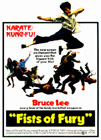 FISTS OF FURY FISTS OF FURY
Released 1971 - Approx. 101 min
Starring Bruce Lee, Maria Yi, James Tien , Nora Maio,
Tony Liu and Han Ying Chieh
Directed by Lo Wei
Featuring: The lightening kicks of Bruce Lee on screen for the first time.
The setting is in Bangkok, Thailand. Before Bruce left China to Thailand, he promised his mom that he won't get in any fights and troubles. Strangely, some workers from the ice factory where Bruce works, vaporized. To find out what's going on, Bruce goes to see the boss; thus, realizing that the boss is involved in this event. Then, Bruce starts a fierce battle with the boss and the gangs.
|
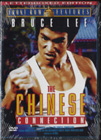 THE CHINESE CONNECTION THE CHINESE CONNECTION
Released 1972 - Approx. 107 mins
Starring: Bruce Lee, Nora Miao Ker Hsiu, C H wong, Y C Han, James Tien, Robert Baker
Directed by Lo Wei
Featuring: The 2 scenes that Bruce goes to challenge the Japanese martial art school
Setting: In the early 1900's, Shanghai, China.
Story: Teacher Fok died in a sudden. Bruce Lee as Chan Chen,
came back to Shanghai for his teacher's funeral. During the funeral, some Japanese came and pissed off Bruce's group as "Sick men of Asia". That's why Bruce challenged the Japanese martial art school. Later on, Bruce found out that his teacher was poisoned to death by a Japanese undercover from the Jap martial art school. Finally, Bruce took his revenge and killed all the god damn Japanese, as a result of devoting his life to preserve the JING WU SCHOOL.
|
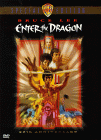 ENTER THE DRAGON ENTER THE DRAGON
Released 1973 - Approx. 99 mins
Starring: Bruce lee, Shih Kien, John Saxon, Ahna Capri, Bob Wall and Bolo Yeung
Directed by Robert Clouse
Featuring: Bruce, the first time as the main character in Hollywood films
Story: Shaolin student Bruce was asked to cooperate with the FBI to investigate on a drug island controlled by Shih Kein. Unfortuneately, Bruce was captured as he's doing his spying. One thing for sure, Bruce is mightier than Shih. Finally, Bruce and Shih have a great fight at the end of the film and the FBI came to bust up the operation.
|
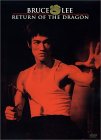 RETURN OF THE DRAGON RETURN OF THE DRAGON
Released 1973 - Approx. 88 minutes
Starring: Bruce Lee, Chuch Norris, Nora Miao Ker Hsiu
Directed by: Bruce Lee
Featuring: Fight with Chuck Noris
Bruce Lee wrote and directed Return of the Dragon, his third film, a mix of hard-edged kung fu and goofy humor. Once again he plays the country boy who travels to a foreign land, in this case Italy, where his restaurant-owning cousins face trouble from the local syndicate. Their strong-arm tactics have driven customers away and now threaten the family, but Lee refuses to buckle under their pressure and takes them on in a series of impressive confrontations. The film ends with a memorable showdown with world-champion karate artist Chuck Norris in the Roman Colosseum (though much of it is staged in a rather cheap studio set), a brutal, almost inhuman battle that revels in the intense punishment taken by the combatants.
|
 GAME OF DEATH GAME OF DEATH
Released 1978 - Approx. 95 mins
Starring: Bruce Lee, Gig Young, Dan Inosanto, Kareem Abdul Jabaar, Dean Jagger,
Colleen Camp and Hugh O'Brian
Directed by Robert Clouse
Featuring: Bruce VS Dan Inosanto & Kareem Abdul Jabaar
Bruce Lee died after shooting only a few scenes of his ambitious Game of Death, but that didn't stop greedy producers from finishing and releasing "Lee's last film," even if he's doubled for most of it. Lee planned an ambitious expression of his fighting philosophy, and his story culminates in the rigorous challenge of the "Game of Death," in which combatants take on successively greater and greater masters as they fight their way to the top of a tower.
| Bruce Lee also starred in these other films and documentatries. |
Green Hornet:
- Green Hornet - Pilot and Promos
- Bruce Lee in Green Hornet I - "The Green Hornet" (Asian re-mix)
- Bruce Lee in Green Hornet II - "Fury Of The Dragon" (Asian re-mix)
- Green Hornet Strikes Again
- Green Hornet #1 (episodes 01-04)
- Green Hornet #2 (episodes 05-08)
- Green Hornet #3 (episodes 09-12)
- Green Hornet #4 (episodes 13-16)
- Green Hornet #5 (episodes 17-20)
- Green Hornet #6 (episodes 21-24)
- Green Hornet #7 (episodes 25-26 + Batman "Piece Of The Action" I & II)(All Green Hornet episodes are commercial free)
|
Other:
- Bruce Lee - A Warrior's Journey (2002 documentary)
- "Bruce Lee - The Legend" (1984 documentary)
- "The Green Hornet Tape" (featuring 3 episodes, Batman clip, interviews (Van Williams on Entertainment Tonight) and 3 trailers + Bruce Lee's screen test)
- "Bruce Lee - The Beginning" (first screen test, + featured appearances in four Green Hornet TV shows)
- A&E Original Biography + "Piece Of The Action" (Batman & Robin vs. The Green Hornet)
- "Bruce Lee - The Curse Of The Dragon" (fight scenes, interviews, Brandon, home movies, tournament, and funeral footage)
- "Bruce Lee's Biography - The Man, The Myth" (An action-filled kung fu movie telling the story of Bruce Lee)
- "The Real Bruce Lee" (includes rare footage from: "The Little Dragon", "The Bad Boy", "Carnival", and "Orphan Sam")
- Longstreet - "Way Of The Intercepting Fist" (pilot)
- Bruce and Brandon Lee Compilation I (E! News Update and Los Angeles Eyewitness News report on Brandon's death, "Dragon" opening, Bruce's Star on the Hollywood Walk Of Fame, behind the scenes footage with Bob Wall, and Fred Weintraub, E! News Week In Review, Hard Copy "The Curse Of The Crow" exclusive home video from the movie set)
- Bruce and Brandon Lee compilation II ("Crime Wave", "The Ray Is For Killing", Batman clip, Black Beauty profile, Van Williams "Where Are They Now?", Green Hornet trailers, "Marlowe" clips, behind the scenes "Enter The Dragon", childhood movie clips "Kid Cheung", "The Bad Boy", "Carnival", and "Orphan Sam", funeral footage, clip from "The Tennant", FX clip, E! Entertainment report on Brandon's death "Haunted Hollywood")
- A&E Biography (updated) + Unsolved Mysteries (Bruce and Brandon's deaths)
- "Fist Of Bruce Lee" starring Bruce Lee (1978)
- "Bruce and Dragon Fist" starring Bruce Le (1979)
Books & Publications About Bruce Lee
Books written by Bruce Lee
- Bruce Lee : Artist of Life (Bruce Lee Library)
- Bruce Lee's Fighting Method : Basic Training
- Bruce Lee's Fighting Method : Basic Training (Volume 2)
- Bruce Lee's Fighting Method : Skill in Techniques, Volume 3, Number 404
- Bruce Lee's Fighting Method : Advanced Techniques, Volume 4, Number 405
- Bruce Lee : Words from a Master
- Chinese Gung Fu : The Philosophical Art of Self Defense
- Jeet Kune Do : Bruce Lee's Commentaries on the Martial Way (The Bruce Lee Library, Vol 3)
- Striking Thoughts: Bruce Lee's Wisdom for Daily Living
- Tao of Jeet Kune Do
- The Art of Expressing the Human Body (Bruce Lee Library)
- The Tao of Gung Fu : A Study in the Way of Chinese Martial Arts (Bruce Lee Library, Vol 2)
- Words of the Dragon : Interviews 1958-1973 (Bruce Lee Library, Vol 1)
|
|
|
|
|
|
|
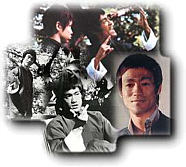 "With nothing but his hands, feet and a lot of attitude, he turned the little guy into a tough guy." -- Time
"With nothing but his hands, feet and a lot of attitude, he turned the little guy into a tough guy." -- Time

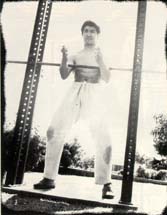
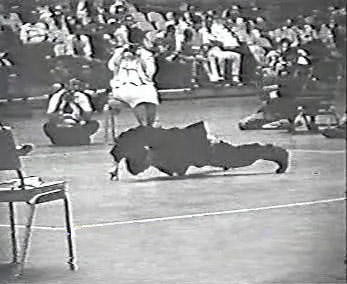
 FISTS OF FURY
FISTS OF FURY THE CHINESE CONNECTION
THE CHINESE CONNECTION ENTER THE DRAGON
ENTER THE DRAGON RETURN OF THE DRAGON
RETURN OF THE DRAGON GAME OF DEATH
GAME OF DEATH